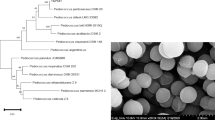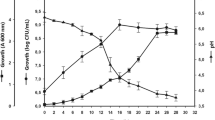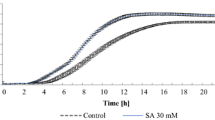Abstract
Objective
To examine whether choline and its derivatives can be used to preserve viable cells of Lactobacillus reuteri in autolytic models.
Results
A phosphate-induced autolytic model in de Man, Rogosa and Sharpe medium (MRS) was used. Viable cell counts were determined by plated on MRS-agar. Choline and hemicholinium-3 (HC-3) significantly blocked autolysis of L. reuteri at 360 mM and 4 mM, respectively. Viable cell counts corroborated these observations. Importantly, autolytically induced cells treated with choline and hemicholinium-3 were significantly more viable then even non-induced cells. Over-production of a known autolytic protein, spirosin, was not attenuated in the presence of choline and hemicholinium-3.
Conclusion
Inducing autolysis and then blocking it with choline and its analogs is a promising approach for retaining the viability of L. reuteri cells.

Similar content being viewed by others
References
Apas AL, Gonzalez SN, Arena ME (2014) Potential of goat probiotic to bind mutagens. Anaerobe 28:8–12
Holtje JV, Tomasz A (1975) Lipoteichoic acid: a specific inhibitor of autolysin activity in Pneumococcus. Proc Natl Acad Sci USA 72:1690–1694
Lakritz JR, Poutahidis T, Levkovich T, Varian BJ, Ibrahim YM, Chatzigiagkos A, Mirabal S, Alm EJ, Erdman SE (2014) Beneficial bacteria stimulate host immune cells to counteract dietary and genetic predisposition to mammary cancer in mice. Intern J Cancer 135:529–540
Lee J, Yang W, Hostetler A, Schultz N, Suckow MA, Stewart KL, Kim DD, Kim HS (2016) Characterization of the anti-inflammatory Lactobacillus reuteri BM36301 and its probiotic benefits on aged mice. BMC Microbiol 16:69
Mani-Lopez E, Palou E, Lopez-Malo A (2014) Probiotic viability and storage stability of yogurts and fermented milks prepared with several mixtures of lactic acid bacteria. J Dairy Sci 97:2578–2590
Perricone M, Corbo MR, Sinigaglia M, Speranza B, Bevilacqua A (2014) Viability of Lactobacillus reuteri in fruit juices. J Funct Food 10:421–426
Podvin L, Reysset G, Hubert J, Sebald M (1988) Presence of choline in techoic acid of Clostridium acetobutylicum N1-4 and choline inhibition of autolytic functions. J Gen Microbiol 134:1603–1609
Tomaro-Duchesneau C, Jones ML, Shah D, Jain P, Saha S, Prakash S (2014) Cholesterol assimilation by Lactobacillus probiotic bacteria: an in vitro investigation. Biomed Res Int 2014:380316
Varian BJ, Goureshetti S, Poutahidis T, Lakritz JR, Levkovich T, Kwok C, Teliousis K, Ibrahim YM, Mirabal S, Erdman SE (2016) Beneficial bacteria inhibit cachexia. Oncotarget 7:11803–11816
Yamato M, Tomotake H, Shiomoto Y, Ota F (1995) Chromatographic study of spirosin by use of monoclonal antibodies to spirosin of Yersinia enterocolitica. Microbiol Immunol 39:255–259
Yamato M, Nakada R, Nakamura Y (1998) Release of spirosin associated with potassium phosphate-induced autolysis in Lactobacillus reuteri DSM 20016. Microbiol Res 153:29–35
Acknowledgements
This work was supported by the Agricultural Research Program at North Carolina Agricultural and Technical State University with funding from the USDA National Institute of Food and Agriculture, Hatch project number NC. X-234-5-09-170-1.
Supporting information
Supplementary Table 1—Initial pH values and the calculated buffer capacities of MRS-KP alone and with choline or HC-3
Supplementary Figure 1—Densiometry values for the intensity of spirosin band
Supplementary Figure 2—Titration curves for MRS-KP alone and with choline and HC-3
Author information
Authors and Affiliations
Corresponding author
Ethics declarations
Conflict of interest
The authors declares that they do not have conflict of interest.
Electronic supplementary material
Below is the link to the electronic supplementary material.
Rights and permissions
About this article
Cite this article
Zimmerman, T., Gyawali, R. & Ibrahim, S. Autolyse the cell in order to save it? Inducing, then blocking, autolysis as a strategy for delaying cell death in the probiotic Lactobacillus reuteri . Biotechnol Lett 39, 1547–1551 (2017). https://doi.org/10.1007/s10529-017-2380-8
Received:
Accepted:
Published:
Issue Date:
DOI: https://doi.org/10.1007/s10529-017-2380-8




